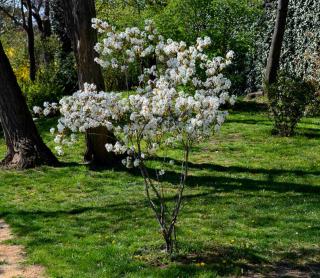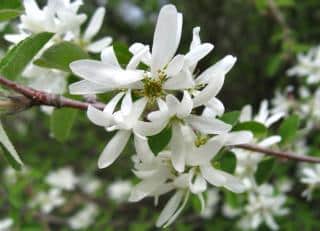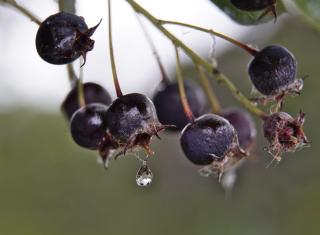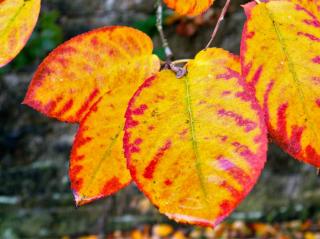

Amelanchier is an ideal tree when setting up a mixed and flowered hedge.
Summary of Amelanchier facts
Name – Amelanchier
Family – Rosaceae
Type – shrub
Height – 6 to 13 feet (2 to 4 meters)
Exposure – full sun
Soil – ordinary is fine, rich if possible
Foliage – deciduous – Flowering – spring
Magnificent from spring to fall, its flowers and berries are its strongest assets.
Amelanchier is planted indifferently in fall or in spring, selecting a spot that is well endowed with sun for beautiful blooming.
 Amelanchier prefers rather rich, deep and well-drained soil, but any type of garden soil can do. It’s not a very picky tree.
Amelanchier prefers rather rich, deep and well-drained soil, but any type of garden soil can do. It’s not a very picky tree.Be careful, if you’re planting in spring, it is a good idea to water regularly during the 1st year after planting.
 It isn’t necessary to prune the plant, but it can be useful when stems start getting tangled up.
It isn’t necessary to prune the plant, but it can be useful when stems start getting tangled up.
If you wish to reduce or balance the shrub out, wait for the end of the blooming.
If not, you’ll be compromising any chance of seeing flowers appear.
 Between 10 to 16 feet (3 to 5 meters) tall, Amelanchier is one of those beautiful shrubs that bloom very early in the year and that contribute to making our gardens elegant.
Between 10 to 16 feet (3 to 5 meters) tall, Amelanchier is one of those beautiful shrubs that bloom very early in the year and that contribute to making our gardens elegant.
Flowers cover the tree in a beautiful white suit early April, preparing a feast for bees.
On top of its cute star-shaped flowers, it stays ornamental all year long thanks to its beautiful leafage that ranges from bronze hues in spring to red and gold in autumn.
Amelanchier flowers are indeed star-shaped, generally white, but some varieties can be a bit pinkish.
The purple-colored berries, if they’re not all picked by birds, will be great for baking delicious pies and jam.
Called serviceberries or other names like rock pear depending on the variety, these fruits are indeed edible and can also be eaten raw.
 In Quebec, chuckley pear is the name they go by.
In Quebec, chuckley pear is the name they go by.
It is easy to care for and adapts to being added to a shrub bed, grown as a standalone, but its most relevant use is as a mixed hedge or a flowered hedge.
Lastly, note that amelanchier attracts birds, which is true for any of the 25 varieties that comprise this genus.
The fruits born by amelanchier are perfectly edible and will attract birds to your garden.
Your comment is awaiting moderation.
What exactly is “Ordinary” soil???? Asking for a friend…..
Hi Brandon… sorry that the wording was so generic! You can tell your friend that I meant any type of garden soil. Amelanchier isn’t a choosy tree, it’ll bloom and grow fine virtually anywhere. No need to measure pH, add this or that… So plant without fear! I rephrased it a bit and added specifics in the planting portion, just to make it clearer for future readers.